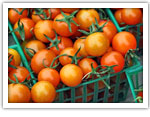 |
Khai McBride Certified Mortgage Planner Skyline Financial Corp. Phone: 800.399.6890 Fax: 800.399.6891 khai@mcbridegroup.com www.mcbridegroup.com |
 | ||
| ||||
July 2007

|
You Say Tomato... Making the Most of the Summer Harvest By Kirk Leins
For tomato lovers everywhere, the summer months mark the time of year when this wonderful fruit is at its absolute tastiest. Whether a summertime tomato is harvested from a backyard garden or purchased from a quality purveyor, it is simply one of the finest fresh ingredients available to nearly every home chef. What is a Tomato? Within the plant world, tomatoes are members of the nightshade family (Solanaceae). While the nightshade family is responsible for other healthy offerings – such as potatoes, eggplant, and peppers – it also includes some very toxic plants like the deadly nightshade (belladonna). It’s a high concentration of alkaloids that makes belladonna, as well as the green foliage of most nightshade plants, so dangerous. The irony here is that the production of alkaloids is a normal biochemical activity for most plants. Alkaloids contain nitrogen and actually help protect plants from being completely devoured by insects. The good news is when it comes to the food produced by nightshades, the alkaloid level is relatively low. However, these low levels do explain some people’s aversion to the aforementioned nightshade foods. If you are sensitive to these types of foods, I recommend eating them in smaller doses and only when they are ripe. Ripening, along with cooking, dramatically reduces these already low alkaline levels. This probably explains why some people could never eat a raw green bell pepper but have no problem when a red bell pepper (a more ripened version) is sautéed in olive oil or fire-roasted over a hot grill. Tomato History Somehow, tomatoes managed to migrate north into Central America and Mexico sometime in the early 16th century. Once the Spanish began colonizing the Americas, the tomato spread worldwide as they brought the newfound fruit to their colonies in the Caribbean as well as the Philippines and Europe. Tomatoes grew quite easily in Mediterranean-type climates, and by the mid-1500s they began making their way through Europe, starting with Spain and Italy. Tomatoes weren’t seen in British North America until the early 1700s, in the area now known as South Carolina. Many believe the fruit came to us via the Caribbean as opposed to any of our neighbors from the south. Regardless, by the mid-1700s, tomatoes were being cultivated throughout what is now the southern United States. During this time, many people actually thought the tomato was poisonous and, in turn, used it more as an ornamental plant. This misinformation was most likely due to the scientific finding (by the British) of high alkaloid concentrations within the stems and leaves of the plant, not the tomato itself. It wasn’t until the late 1700s that more traveled Americans, like Thomas Jefferson, visited Paris and came back raving about the deliciousness of the tomato. Speaking of Paris, I find it slightly ironic that the gastronomically advanced French really didn’t begin experimenting with tomatoes until the late 18th century – and they have the Italians to thank for it! It was the Italians who brought the tomato into Provence, and from there it took off, as its bright red color became an edible symbol of the French Revolution. Nonetheless, it is now the 21st century and the whole world loves tomatoes. Like many other plants, each tomato cultivar grows better in specific climates as well as during specific times of the year. As opposed to attempting to break down every cultivar, I thought I’d take a few moments to talk about a few broader tomato classifications. Cherry and Grape Tomatoes Beefsteak Tomatoes Tomatoes in general go from perfectly ripe to rotten very quickly. So quickly, in fact, that it is very hard for large growers to transport their tomatoes without the fruit going south. For many, the solution is to pick the tomatoes while they’re still green and then ripen them artificially in an ethylene bath. This practice may make the tomatoes travel better but it results in the purchase of a virtually unripe piece of fruit. My personal solution is to buy these larger tomatoes from either quality markets where they are sold still on the vine, or from vendors who set up stands by the roadside or inside of farmer’s markets. Tomatoes sold by these purveyors are not only vine-ripened, but they are also brought to market on a more regular basis and intended for quicker consumption. They are well worth any extra money they cost. But it’s important to know that when it comes to great taste at a low price, nothing beats a tomato that’s grown in a backyard garden. Speaking of great taste, one classification of tomato that is turning up everywhere is known as an Heirloom. While they do vary in size and color, tomatoes tagged as Heirlooms share a few common traits. First and foremost, they must be naturally pollinated and have received no artificial genetic modifications. After that, however, there is much dispute over which tomatoes qualify. Most of the debate is either over how long the strain has been in existence, or the method in which the seeds were handed down. Regardless, if you can get your hands on Heirloom Tomatoes, I recommend doing so. For any of these larger tomato varieties, I love slicing them thinly and using them on any burger or sandwich. My second recipe this month will be one of my favorite sandwiches featuring the tomato. Plum Tomatoes Unless I can procure a high quality, fresh plum tomato, my personal preference is to buy them canned. If you want to do the same, you should look for plum tomatoes that are grown and packed in the San Marzano region of Italy, as these are some of the sweetest available. They are great for sauces, stews, and even quick blender salsas. For the most part, when I cook with tomatoes as part of a dish, I prefer using canned rather than fresh as they produce a more consistent result. The only exception I’ll make is when I have an abundance of summertime tomatoes on hand and desperately need to use them up. My last recipe will show you how to do just that. Cherry Tomato and Cucumber Salad (Serves 3 to 4)
For the dressing:
In a large bowl, mix together all the dressing ingredients. Add cucumber slices, tomato halves, and basil leaves, and toss to combine. Taste and adjust seasonings if necessary. Allow the salad to sit at room temperature for at least one hour. Liberally scatter crumbled goat cheese on top of salad and serve. Note: While the salad can be made ahead of time, it is at its best when eaten on the day it’s made. The Ultimate B.L.T.A. (Makes 2 sandwiches)
In a bowl, combine avocado and lemon juice. Season the ingredients with salt and pepper, and mash well with a fork. Spread equal portions of avocado mixture on two slices of bread. Spread the remaining two slices of bread with mayonnaise. On the slices with the avocado, layer an equal number of tomato slices and season with salt and pepper. Top with an equal number of bacon slices, lettuce, and remaining slices of bread. Cut in half on the diagonal and serve. Roasted Tomatoes with Shrimp and Tarragon (Serves 2 to 4)
Preheat your oven’s broiler. Combine all of the ingredients, except shrimp, in a gratin dish or small casserole dish. Toss to fully combine and roast in broiler for 10 minutes. Remove dish from broiler, add shrimp, and toss again. Return dish to the broiler and roast until shrimp are pinkish and opaque, approximately 5 to 7 minutes. Remove from broiler, garnish with remaining parsley, and serve along with crusty bread. Good luck and happy tomato season!
| ||||||||||||||||||||||||||||||
You are receiving a complimentary subscription to YOU Magazine as a result of your ongoing business relationship with Khai McBride. While beneficial to a wide audience, this information is also commercial in nature and it may contain advertising materials. INVITE A FRIEND to receive YOU Magazine. Please feel free to invite your friends and colleagues to subscribe. SUBSCRIBE to YOU Magazine. If you received this message from a friend, you can subscribe online. UNSUBSCRIBE: If you would like to stop receiving emails from Khai McBride, you can easily unsubscribe. Skyline Financial Corp. |
26840 Agoura Road Calabasas, CA 91301 Powered by Platinum Marketing © Copyright 2024. Vantage Production, LLC. | |||||||||



 Kirk Leins has been cooking his entire life. No stranger to professional kitchens, he currently devotes most of his time to cooking instruction, food writing, and producing television. Kirk also provides his services as a personal chef in and around the Los Angeles area. He has made several TV appearances on both the national and local level, and is the Executive Chef for YOU Magazine. His free newsletter, The Everyday Gourmet, is available by contacting Kirk at
Kirk Leins has been cooking his entire life. No stranger to professional kitchens, he currently devotes most of his time to cooking instruction, food writing, and producing television. Kirk also provides his services as a personal chef in and around the Los Angeles area. He has made several TV appearances on both the national and local level, and is the Executive Chef for YOU Magazine. His free newsletter, The Everyday Gourmet, is available by contacting Kirk at